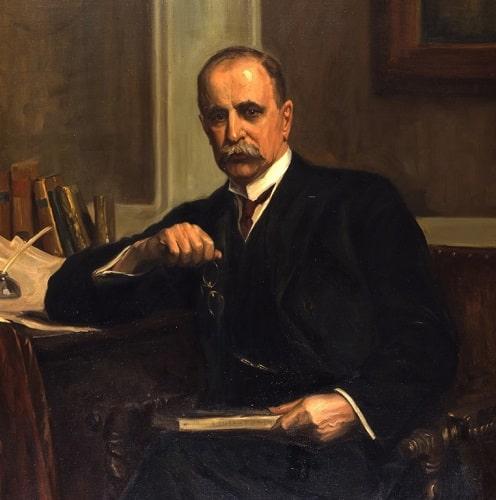William Osler was born at Bond Head, Ontario, the sixth son of Rev. Featherston L. Osler, who had emigrated from Falmouth, and his wife Ellen Free, daughter of Thomas Pickton of London. At Trinity College School near Toronto, the Anglican warden, Father Joseph — as he was known — inspired him with a love of nature and of books; Browne’s Religio Medici, Epictetus and Marcus Aurelius became his boyhood’s companions and influenced his thought throughout his days. He began to study medicine at Toronto University and completed his training at McGill University, Montreal, graduating in 1872. He now made a long tour of European medical centres, which included fifteen months in the physiological laboratory of University College, London, under Burdon Sanderson. When he returned to Montreal, he was made, at the age of twenty-five, professor of the institutes of medicine at McGill; his election as physician to the Montreal General Hospital followed in 1878. At McGill, he engaged in pathological research and lectured on physiology and pathology with such success that in 1884 he was invited to fill the chair of medicine in the University of Pennsylvania. After five years in this post he accepted the appointments of first professor of medicine at Johns Hopkins University, Baltimore, and physician to the Johns Hopkins Hospital,, founded as an integral part of the Medical School.
Osler’s fifteen years at Baltimore were the most remarkable in his memorable career. Given the opportunity to organise a new medical school, by combining the best features of English and German methods — the bedside instruction of the one and the co-ordination of wards and laboratories of the other — he established an institution that revolutionised the teaching of medicine in the United States and Canada. This period also witnessed the publication of Osler’s magnum opus. The Principles and Practice of Medicine (1892), and his monographs on Cerebral Palsies of Children (1889) and Chorea and Choreiform Affections (1894). The former was the first textbook to embrace the changes in the classification of diseases produced by current advances in bacteriology; immensely popular, it reached a sixteenth edition in 1947 and was translated into French, German, Spanish and Chinese.
The strain of his work at Johns Hopkins and of his widespread practice made the offer of the Regius chair of medicine at Oxford, when it was made in 1904, highly acceptable to Osler. Oxford appealed to him by its unhurried calm and cultural traditions, and to Oxford he brought a varied and cosmopolitan experience unequalled by his predecessors. Both the Oxford Medical School and the Radcliffe Infirmary — to which he acted as an exceptionally energetic consulting physician — prospered under his guidance; he expanded the departments of pathology and physiology and at the same time increased the facilities for clinical instruction. His influence extended throughout the University, for his enthusiasm for literary and antiquarian pursuits, hitherto suppressed, and his unsurpassed hospitality brought him into contact with men of every taste and every group. An ardent bibliophile, he was a curator of the Bodleian Library and a delegate to the Clarendon Press. Some of his later writings had a wide appeal — among them Aequanimitas (1904), An Alabama Student (1908), Man's Redemption of Man (1910) and A Way of Life (1913).
To the Royal College of Physicians, Osler delivered the Goulstonian Lectures in 1885, the Harveian Oration in 1906 and the Lumleian Lectures in 1910. Universities and learned societies showered their honours upon him, and he received a baronetcy in 1911. Osler earned the love of his fellows and pupils as well as their respect, for the inspiration which had so advanced the progress of medicine in three countries was tempered by a simple modesty, a kindly good humour and an unvarying humanity. The Lancet described him as "the greatest personality in the medical world at the time of his death", and without doubt he was then the best-known physician on both sides of the Atlantic.
He married in 1892 Grace, widow of Dr. S. W. Gross of Philadelphia. She was the daughter of John Revere, a manufacturer, of Boston, and a great granddaughter of Paul Revere of the famous midnight ride. They had one son. Osler died at Oxford.
G H Brown
[Lancet, 1920; B.M.J., 1920; A. G. Gibson, Radcliffe Infirmary, 1926, 152; D.N.B., 1912-21, 417; H. Cushing, Life of Sir William Osler, 2 vols., 1926]

